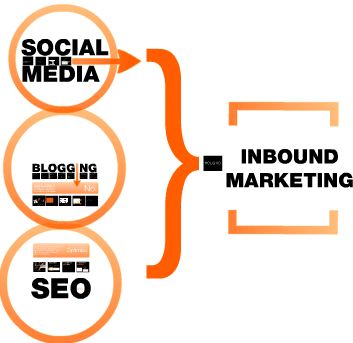Last Updated on July 20, 2020 by John Prendergast
Quick recap of our definition of Inbound Marketing from part 1 of our series, Stop Selling:
Inbound Marketing works on the principle that brands ought to earn their way into customers lives by letting customers find them. Inbound Marketing focuses on digital marketing efforts like search engine optimization, digital content creation (ebooks, blogs, how-to videos), and social media (Twitter, Facebook, LinkedIn) to establish thought leadership, generate leads and convert those leads into clients. Inbound marketing is also known as permission marketing, as opposed to advertising which is known as interruption marketing.
Ok cool. So getting found by customers is the new thing, I get that. Now if only someone would tell me…
HOW THE HELL DO I GET FOUND!?

The Hard Way – Getting found on Google
I’m going to be honest with you – landing on the first (or even second) page of Google search results is no walk in the park. Not only is it difficult, but by the nature of Google algorithms it will take a decent chunk of time. Not only does this require that you have a website, but with Google’s latest updates to their algorithm, you also have to consistently update your website AS WELL as maintain a steady flow of traffic. If you’re not so clear on the lexicon of the internet and search, it may be useful to have this SEO Glossary open while you’re reading the following links.
That being said, SEO is not dead. Here are a few choice resources for search engine optimization:
Hubspot’s Keyword Tips (with a link to the free Intro to SEO e-book at the end)
Google Search Engine Optimization Starter Guide (A more technical SEO guide)
Tips For Writing SEO Friendly Blog Posts (Since original content is key to inbound marketing)
SEO For Non-Dicks (My personal favorite SEO piece. “Good SEO is a by-product of not being a dick.”)
And a tool for checking up on your SEO from Hubspot: The Website Grader
The Easy Way – Getting found on social media
Getting found on social media is way easier than getting your website on the first page of organic Google search results. Here are a few quick tips to get started:
- Networks: Twitter and LinkedIn are what you need to get your business found. Facebook is a reasonable addition, but by no means a focal point. A Google+ page, although mostly irrelevant for advisors (and everyone except tech/social media junkies) WILL help your search rankings.
- Profiles: Optimize your bio for your profession – Include your certifications, the firm that you work for, and a link to your website (if you have one). Also, make sure people know where you’re based out of, and if you have extra room add a bit of wit or personality to your bio.
- Pictures: Keep a consistent avatar or profile picture across all networks, it helps people recognize you. Also, ALWAYS have the picture be you – a person. Logos aren’t very personal.
- Groups, Lists and Hashtags: On LinkedIn, join and engage with relevant groups – these groups may be by profession or locale, both will be beneficial to you. On Twitter, create lists to help you find the information you need, faster. Also on Twitter, be sure to pay attention to the hashtags people in the finance space are using, and use them yourself to join the conversation and get found. Make use of Twitter search and the new “discover” feature to find like-minded users.
- Connections and Followers: On LinkedIn, don’t just go connecting with every financial advisor in town. As with everything in life, quality over quantity almost always holds true. If you haven’t met them in real life or significantly communicated with them over the web, it’s probably best not to connect with them yet. On the other hand, finding them on Twitter and reaching out there might be a better option. Speaking of Twitter, since following isn’t mutual, feel free to follow whoever you want, just try to keep your following:follower ratio reasonable (I recommend not much more than 2:1).
For best practices on what to share on these networks, check out our post on diagnosing an #advisorfail on Twitter – the content sharing rules are similar on LinkedIn. The basic rule is that you don’t want to be too promotional or sales-y. Promote those whom you connect with, and always give credit when credit’s due, that way when it comes time to promote yourself people won’t already be sick of you!
Luckily for you – social influences search!

Google recently changed their algorithm to give higher priority to results for people with larger social followings, but they also give higher ranking to content with lots of social shares. This is great news for you. If you develop a sizable social following, a simple google search for your name should return results of your social profiles and popular articles you’ve shared. AWESOME! Here’s a quick excerpt from a piece on Social Content in SEO:
Let’s start with the obvious: social media builds links. In fact, viral content serves the same purpose as a link building campaign: gathering endorsements that establish authority and legitimacy in your field.
Search engines boil down to one basic concept: helping users find what they’re looking for. Large amounts of social shares indicate that a mass amount of people not only found what they were looking for on your site, but also liked your site enough to share it with others.
Ok, so socially shared content is great for SEO, and you can get away with this just by having a Twitter, Facebook, LinkedIn, etc. But you know what’s better than all those things? YOUR OWN WEBSITE TO HOST CONTENT ON. Fortunately, it’s super easy and completely free to get your own blog/website. In fact, I suggest you lose the slash and get both. For advisors, you’re probably best going with a WordPress blog and an About.me splash page. OK, so you’ve got your blog set up. What are you supposed to write? We’ve got plenty on the why/what/how/when of content already on the blog:
- A Simple Strategy for Financial Content That Works
- How To Not Have a Sucky Financial Blog
- The Perfect Time To Post
Know of an advisor who’s killing it on social media? Which advisor has the best blog? Let us know in the comments, and, as always, stay in touch with #BLNation by subscribing below!